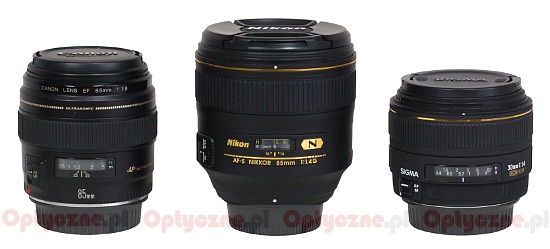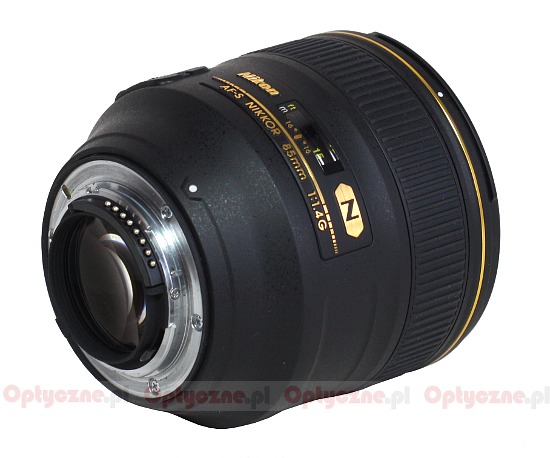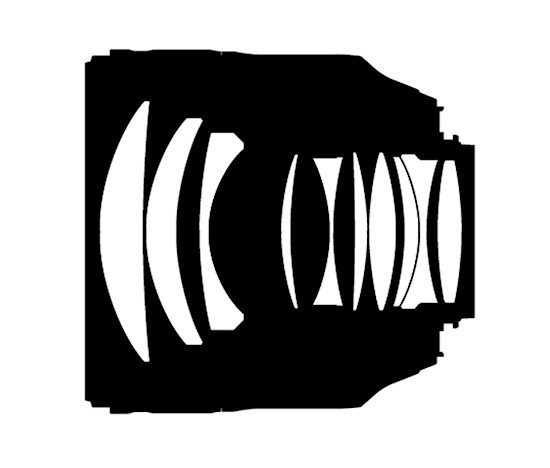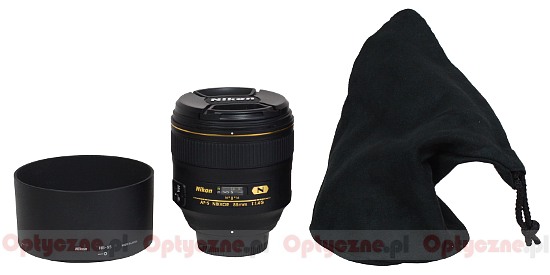Nikon Nikkor AF-S 85 mm f/1.4G
3. Build quality
The photo below shows the Nikkor AF-S 85 mm f/1.4G positioned between the Canon EF 85 mm f/1.8 and the Sigma 30 mm f/1.4 EX DC.
 |
Please Support UsIf you enjoy our reviews and articles, and you want us to continue our work please, support our website by donating through PayPal. The funds are going to be used for paying our editorial team, renting servers, and equipping our testing studio; only that way we will be able to continue providing you interesting content for free. |
- - - - - - - - - - - - - - - - - - - - - - - - - - - - - - - - - - - - - - - - - - - - - - - -
The barrel of the new Nikkor 1.4/85 is made of magnesium alloys. It is also weather-sealed to prevent the ingress of dust and humidity inside and make the shooting possible in even the most difficult conditions.
The lens starts with a metal bayonet mount in which we find bolt-shaped contact pins, so characteristic for a Nikon mount. Inside the mount you can find a rear element with a diameter of 32 mm. It is immobile and quite shallowly set because it is hidden only about 0.5 cm inside the barrel.
 |
The mount turns into a smooth and quickly bulging casing. On it you see a clear distance scale behind a window, expressed in feet and meters. On its one side there is the producer’s logo, on the other side a big N letter (meaning that NanoCrystal coatings were used). Right below the distance scale we find depth of field markings for f/16 aperture and even lower - the full name of the lens. On the left side there is also a focusing mechanism mode switch (M and M/A).
Moving on towards the front element we see a manual focus ring. It is ribbed and 19 mm wide. Its work would be difficult to fault – it operates smoothly and is well-damped. The range of turn might be a kind of problem, though. A lens with such parameters gives a very shallow depth of field. If you want to focus it manually you must be able to make very small, precise movements. Meanwhile running through the scale needs a turn of about 100 degrees. In some situations, this value is too low to guarantee the necessary manual focusing precision. For comparison the Voigtlander Nokton 58 mm f/1.4 SL II, tested by us not so long ago, has the range of the focus ring amounting to as much as 210 degrees although it gives a deeper depth of field than the Nikkor.
Behind the manual focus ring we will also find a golden strip and a hood thread. The lens ends with a non-rotating filter thread, 77 mm in diameter, which surrounds an immobile front element, with a diameter of almost 6 centimeters.
Both front and rear elements don’t move. Focusing is performed through the movement of elements inside the lens (that’s why we have the IF symbol on the barrel), a feature which differs this device from older constructions, where the focus was set by shifting the whole optical system. The changing focal length is the price we must pay for better sealing, though.
Inside the lens there are 10 elements in 9 groups. The producer doesn’t boast of using elements of any special kind or shape. The whole picture is complemented by a circular aperture with nine diaphragm blades which can be closed down to f/16.
 |
The buyer gets both caps, a HB-55 lens hood and a soft case included in box.
 |






